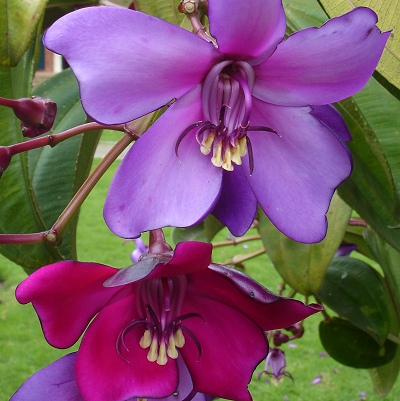Germinating the seeds
When to plant -- Plant them when you receive them for best results. Soil -- The soil should be well-draining and slightly acidic. A typical mix to germinate them in is 1 part peat moss or coir fiber to 1 part perlite (small or medium size, not large chunks) or coarse horticultural sand, with some slow-release fertilizer mixed in. Do not add lime to the mix. Pot size - You may plant all the seeds in a single pot and separate them later, or 2-4 seeds in individual small pots. The pots should have drainage holes. Fill the pots and place the seeds on top.
If you have
long-fibered sphagnum moss Until the seeds sprout, ensure that the surface soil always stays moist. A plastic dome may be used to maintain moisture, but leave it open slightly to allow some fresh air in. You may need to drip a few drops of water over the seeds every day to keep the seeds moist. Place the pots in an area that will stay between 64 and 76° F (18-24°C), although a little cooler at night is ok. Avoid letting them get above 78° F (25°C) for prolonged periods. I recommend placing a minimum/maximum thermometer near the pots. If necessary, place them on the floor of a cool room. Place the pots in a bright spot out of direct sun. An LED or fluorescent bulb kept 4 inches (10 cm) away provides the right amount of light (See: "Growing indoors with LED lights"). They should begin sprouting in 6 weeks, but allow up to 12 weeks for any slow ones, especially at cooler temperatures. Once they sprout, reduce the humidity slightly and increase air flow a bit to avoid rot. Watering: Once they are 3 weeks old, you may allow the surface soil to dry out between waterings, but aim to keep the rest of the soil evenly moist. Never let it dry out completely, but also avoid keeping it constantly soggy. Fertilizing -- The first 2 months, feed
weekly with a small amount of dilute (1/8 strength) liquid fertilizer.
Hydroponic fertilizer
is ideal for small seedlings, because it is easily absorbed and contains all essential
nutrients. After 2 months, you may switch to a granular fertilizer Climate -- The tree is found between 1900 and 2900 meter elevation in Colombia, where temperatures are cool to mild all year, and frost is almost non-existent. Little is known about its climate tolerances, but i suspect it might decline if temperatures consistently rise above 80° F (27°C), especially if nights are warm. It can probably handle a few degrees of frost, but it's wise to protect it from freezing temperatures. It comes from cloud forests, so it appreciates a mix of sun and shade, with some protection from strong afternoon sun. Over about 50% humidity is recommended. Indoors, if the humidity drops too low, consider using an ultrasonic humidifier. Repotting -- Once your seedlings are at least 2 inches tall (5 cm), you may repot them to larger containers. Repot gently and avoid letting the soil ball break apart. Water the soil before repotting to help keep the soil ball together. For the first week or two after repotting, shade from all sun and give no liquid fertilizer. Insects to watch for -- Look for any insects that you find on your other houseplants. Aphids, mealy bugs, and spider mites might bother them, but insecticidal soap spray can control them. Pruning -- If your plants grow too tall, feel free to prune them to keep them short. Have fun growing them! - Jeff Strange Wonderful Things
|
|||||||||


